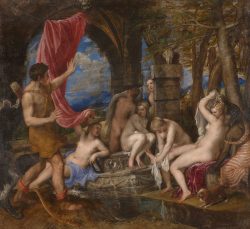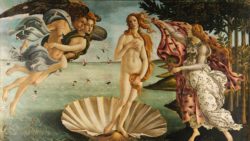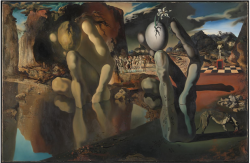Classical Whines is back for whines about the classics and a wine rec. This time, it’s about Ovid’s Metamorphoses; a work that was once on the LitHum syllabus but has since been eviscerated from the Core. As a disclaimer, we are aware that LitHum syllabi may differ slightly between sections, but for our intents and purposes, this article will discuss the standard syllabus from the Core website. Also, Bwog does not endorse underage drinking; the wine recommendation is only for readers who are of legal drinking age.
Dr. Lake, who was my Latin teacher in high school, once said that Ovid’s Metamorphoses is the second most influential piece of literature for western art, after the Bible. I haven’t taken Art Hum yet, so I can’t vouch for this myself, but Dr. Lake said it, so it must be true. But you don’t even need to take Art Hum to see the range of influence that Ovid had on western art. If you’ve ever seen any of the paintings in the gallery below, you have Ovid to thank for the inspiration. (Botticelli’s Birth of Venus isn’t a story that is actually in the Metamorphoses, but this article from the Uffizi Gallery in Florence cites the work as an inspiration for the theme.)
- Diana and Acteon by Titian
- Birth of Venus by Botticelli
- Venus and Adonis by Titian
- Métamorphose de Narcisse by Salvador Dali
To give some context, since we didn’t read it in LitHum, Ovid’s Metamorphoses is a collection of stories, all of which involve metamorphoses of some sort. It’s written in a dactylic hexameter typical of epic poetry, but is not a traditional epic poem, as it is a collection of many short stories about many different topics rather than one long plot dealing with matters of war (compare with Homer’s Iliad and Odyssey, and Vergil’s Aeneid, three canonical epic poems); it’s a play on the traditional epic poem. The only thing that unites some 250 stories is the fact that every single one has some sort of metamorphosis in it. It goes in very loose chronological order from the creation of the world and ends with Caesar (i.e. contemporary times). In between, it covers everything from the flood (yes, the Bible isn’t the only book with a flood), the birth of Bacchus, Medea, and Hercules to the fall of Troy, Aeneas, and Pythagoras. Though these stories aren’t original Ovidian creations but rather reinterpretations of pre-existing myths, it is perhaps one of the most comprehensive collections of such stories. Dante, Shakespeare, Bulfinch, Francis Bacon, Mozart, Chrétien de Troyes, Milton, Cervantes, Titian, and Botticelli are just a few people who were directly or indirectly influenced and inspired by the Metamorphoses.
It’s certainly a controversial work. Ovid has always been controversial, even in his lifetime; Augustus eventually exiled him to the Black Sea for uncertain reasons (“carmen et error” – song and error, according to Ovid himself) where he died. (His Tristia records his woes in exile, and you should read it if you are interested in reading more whines and lamentations.) The Metamorphoses is controversial especially today because many of the stories depict rape and violence. This op-ed in the Spectator from 2015 mentions Apollo and Daphne and the rape of Persephone (or Proserpina, in Latin) as two notable examples. Some other ones with similar implications include stories of Io, Europa, and Philomela. Out of these five, the one with the most graphic rape scene is Philomela. In the story of Persephone, the rape is implied but not described. In the other three, the women in question turn into various things (Daphne into a laurel tree, and Io and Europa into cows). Nevertheless, that doesn’t diminish the significance of the implied intention in any way, especially since the chase is still there.
The op-ed stirred some amount of debate nationally. This piece in The Washington Post was one of the nicer responses to it. Other articles about it lamented today’s liberal higher education and liberal crybabies, all that jazz. Never mind that the op-ed itself does not say it should not be taught but rather calls for “a letter to faculty about potential trigger warnings and suggestions for how to support triggered students,” “a mechanism for students to communicate their concerns to professors anonymously [and] a mediation mechanism for students who have identity-based disagreements with professors,” and “a training program…which will enable them to constructively facilitate conversations that embrace all identities, share best practices, and think critically about how the Core Curriculum is framed for their students.”
In my opinion, these were fair demands to make. The authors of the op-ed are really just calling for a more sensitive way of teaching the Core, which often deals with themes that can be hard to talk about. Even if the story of Daphne, for example, does not actually describe rape, the chase itself vividly describes her fear and Apollo’s desire to seize her, comparing it to a hunt. (It’s ironic that Daphne is the one being chased as a prey here since she wishes to remain a virgin, like Diana, the goddess of the hunt, in the story, not to mention that Apollo is Diana’s twin brother, but that’s beside the point.) It’s really not much to ask that professors who teach the core be sensitive and considerate in dealing with this topic, especially for survivors of sexual assault for whom this may understandably be a difficult work to read and discuss.
Columbia took it one step further, however. Perhaps in response to this op-ed, or for some other reason, Metamorphoses was taken out of the Core that year. In its place, Ovid’s Heroides and Boccaccio’s Decameron were added. (For reference, compare the LitHum syllabi from 2014-2015 and 2015-2016.)
If Columbia took it out because of the controversial rape scenes, it could train professors to deal with the subject more sensitively, as the Spec op-ed suggests (although it pains me to agree with a Spec op-ed). Another option, though not one that I necessarily agree with, is to put only stories without rape or similar implications of sexual violence on the curriculum.
All four paintings in the above gallery are from stories that don’t have anything to do with rape. In Diana and Acteon, Acteon is turned into a deer and killed by his comrades because he accidentally sees Diana in the nude. The Ovidian creation stories, which influenced Botticelli’s Birth of Venus, can be a valuable comparison to Genesis and don’t mention rape. Venus and Adonis is a happy story of Venus and Adonis in love until Adonis is gored by a boar (the scene is no more violent than battle scenes in the Iliad). It’s also a great meta-poetical work; in the story, Venus narrates the story of Atalanta to Adonis from her own perspective. Atalanta’s story also does not include rape; Hippomenes outruns Atalanta in a race, they get married but forget to pay tribute to Venus, and Venus gets mad and turns them into lions. Narcissus is a narcissist (see what I did there?) whose narcissism makes Nemesis angry. She makes him pine after his own reflection until he turns into a narcissus (the flower, otherwise known as a daffodil). Some other stories without rape scenes include Arachne and Minerva, Orpheus and Eurydice, Daedalus and Icarus, and Pyramus and Thisbe (Romeo and Juliet is a direct retelling of this!).
Let’s now turn our attention to the works that, for whatever reason, replaced the Metamorphoses. So much of the Decameron revolves around themes of sexual trickery and blurry consent. In the First Story of the Third Day, the premise is that Masetto pretends to be a “dumb deaf-mute” who works at a nunnery. The nuns are curious about sexual intercourse and take his (feigned) disability to their advantage. In the Tenth Story of the Third Day, the monk Rustico tells the young girl, Alibech, who has “never been intimate with the opposite sex,” that his penis is the devil that must be put back in hell, which is her vagina. In the Second Story of the Fourth Day, Friar Alberto regularly has sex with a woman by telling her that he has assumed the form of the Angel Gabriel. There are more stories like these, but I’ll stop here.
I won’t go into a detailed analysis about sex and consent in the Decameron, because that’s not what this article is about and because that would be a whole another very complicated topic that I could write many, many pages about. My point is that if the Metamorphoses was taken out of the Core because of the rape scenes, it definitely should not have been replaced with the Decameron. The only good reason for this choice would be that it’s the only Renaissance text on the syllabus; I personally think there are better Renaissance texts, but that’s irrelevant to this post.
It’s easier to see the rationale for adding Ovid’s Heroides, the other text that has replaced his Metamorphoses. It retells stories from the Greco-Roman mythological tradition from the perspectives of the women as letters to their lovers. There are fifteen letters in total, but the ones on the syllabus are from Penelope to Ulysses (Odysseus), from Phaedra to Hippolytus, from Dido to Aeneas, from Medea to Jason, and from Sappho to Phaon. I can think of three obvious reasons for this choice. One, it’s another work written by the same author who wrote the Metamorphoses, so it’s a logical replacement. Two, there are many connections and comparisons to be made between these letters and other works on the syllabus (Aeneid, Odyssey, and Sappho). Three, it offers a different, diverse perspective not often heard in the Core: that of women.
To the first reason, I say just bring the Metamorphoses back. To the second, I say that the Metamorphoses‘ stories provide much better connections and comparisons than the Heroides. It’s in conversation with so many texts, and so many later texts are in conversation with it. To the third, I say just add another female author. Proba is just one suggestion off the top of my head. Her Cento Vergilianus de Laudibus Christi is the earliest surviving work by a female Christian author and connects Vergil to the Bible. Marie de France is another possible choice with a wide variety and large volume of work. Maya Angelou would be an excellent, more modern addition.
If the rape and violence are the reasons that the Metamorphoses was taken off the syllabus, at least the more PG13 stories should be on the curriculum to familiarize students with the work. According to the LitHum website, the course is “designed to enhance students’ understanding of main lines of literary and philosophical development that have shaped western thought for nearly three millennia…Lit Hum encourages students to become critical readers of the literary past we have inherited.” We are meant to think about questions like “Why did these works cause previous generations to value them so highly? In what ways are our authors in conversation with each other? How are these books relevant to our lives? In the end, what do we gain from them?” If the Metamorphoses, with its vast influence on western literature and art, and its thought-provoking themes about power, love, the mythological tradition, divinities, humans, and metamorphosis, as well as the controversy that surrounds it and its author for two millennia, isn’t the perfect work to be on this syllabus, I truly don’t know what is.
A good Italian wine to drink (if you are of legal drinking age) while reading the Metamorphoses on your own time, since it’s not on the LitHum syllabus, is Cantina Zaccagnini. Henry likes it because it’s sweet and the bottle has a twig tied around it, which sounds like two great reasons. It’s “like 16 bucks” at International.
All pictures via Wikimedia Commons


 7 Comments
7 Comments








7 Comments
@high-key impressed Youngweon’s eloquent responses to these comments are giving me life.
@anon Indeed, one reason Heroides was chosen was that unlike Metamorphoses, in which one story flows into another, often in ingenious ways, Heroides consists of discrete letters–it’s easy to teach a few. But Metamo is ultimately the more rewarding text and I’m glad to see it coming back.
Thanks to the author of this piece for setting the record straight–the original Spec article asking for more sensitive treatment of material in the Core was grossly misunderstood.
@Youngweon Lee I think Venus and Adonis, for one, is a story that shows a great transition (how Venus tells the story of Atalanta: a story within a story) and is separated clearly enough that it would be easy to add to the syllabus. There are lots of other stories with cleanly divided transitions that could be chosen. I’m happy it will make a return; I really think it’s an essential text.
To add to my point about the Spec op-ed, the authors make the point that they don’t want to take away the instructors’ “academic freedom in teaching the material” but rather “[provide] them with effective strategies to engage with potential conflicts and confrontations in the classroom.” Texts like the Metamorphoses that have explicit sexual violence in them are important because they open up discussions about the role of women in antiquity, how sexual violence was perceived in antiquity, how that’s different from our modern perception, how that might have influenced today’s society’s perception of women and sexual violence, etc. These are very important discussions to have (which is why I said in the article that I disagree with only putting stories without mention of rape on the curriculum), and topics that must be dealt with in a sensitive manner. I think that’s what the authors of the op-ed were getting at, and that, to me, seems like one crucial purpose of the Core.
@anon One caveat to your suggestions for excerpts “without rape scenes”: the story of Arachne is full of scenes of gods raping humans and goddesses–on Arachne’s tapestry, presented as a retort to Athena’s depiction of the generosity and righteous vengeance of the gods. (It’s a fantastic story and works well on the syllabus nonetheless.)
@Youngweon Lee I totally forgot about that, actually; thank you for reminding me. I do agree that it would still work well on the syllabus, especially because of the second point I made in my original response.
@Well Actually It was taken out because it was too long, and hard to excerpt. Nothing to do with triggering material. And it’s going back on next year (despite the difficulty of excepting it meaningfully).
@Youngweon Lee Well, I think you could say that about any other book that we don’t read in full. The same argument can be made about Thucydides, Herodotus, Don Quixote, etc. Arguably, the only books currently on the syllabus that are divided in a way that’s easy to take separate passages from are really Decameron, Montaigne’s Essays, and Heroides.
Also, some stories in the Metamorphoses are connected to others, yes, but many more aren’t. The ones I mentioned in the article are all pretty cleanly separated: Arachne and Minerva, Diana and Acteon, and Philomela, just to name a few.
I didn’t know it was coming back next year, though. That’s great to hear.